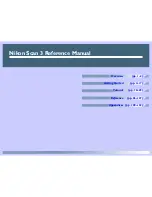
C H A P T E R
Dragon NaturallySpeaking User’s Guide
167
14
Automate Your Work
(Preferred and Professional)
f you have Dragon NaturallySpeaking Preferred or a higher edition, you can
create your own custom voice commands using the MyCommands Editor. These
commands let you automate repetitive text entry and graphics insertion tasks while
working in virtually any Windows application. In some editions of Dragon
NaturallySpeaking you can use the MyCommands command-and-control and
advanced scripting features to create customized macros and scripts to speech-
enable applications and to control them by voice.
There are five types of commands you can create.
■
Text and Graphics, which you can use to enter text and graphics of your
choosing. (Preferred and higher editions)
■
Macro Recorder, which lets you record a sequence of mouse movements and
keystrokes. (Professional and higher editions)
■
Step-by-Step, which lets you activate menu and keystroke commands to control
your application. Step-by-Step commands are useful for controlling applications
and for multistep tasks. (Professional and higher editions)
■
Advanced Scripting, which allows people familiar with programming languages
such as Microsoft® VBA to program commands that can perform virtually any
function on the computer with voice commands. (Professional and higher
editions)
■
Structured Commands are commands that can have assigned states, allowing
you to activate or de-activate a set of commands specific to a state. You can set
the values of these variables to be used as boilerplate text. (Professional and
higher editions)
If you’d like to use Step-by-Step, Macro Recorder, or Advanced Scripting commands and
you have Dragon NaturallySpeaking Preferred or lower edition, you can upgrade to a higher edition
of Dragon NaturallySpeaking. For more information on how to upgrade, see page 217.
In addition to the custom commands described in this chapter, there is another way to create a
command that types up to 128 characters of text. You can use the Vocabulary Editor to create a new
word that has a written form that is different from its spoken form; for instructions, see ”View or edit
I
NOTE
TIP
Summary of Contents for DRAGON NATURALLYSPEAKING 8
Page 1: ...U S E R S G U I D E...
Page 3: ......
Page 4: ......
Page 68: ...5 Correcting and Editing Dragon NaturallySpeaking User s Guide 60...
Page 124: ...9 Using the Command Browser Dragon NaturallySpeaking User s Guide 116...
Page 140: ...1 0 Improving Accuracy Dragon NaturallySpeaking User s Guide 132...
Page 150: ...1 1 Managing Users Dragon NaturallySpeaking User s Guide 142...
Page 184: ...1 4 Automate Your Work Preferred and Professional Dragon NaturallySpeaking User s Guide 176...
Page 202: ...A P P E N D I X Version 8 File Structure Dragon NaturallySpeaking User s Guide 194...
Page 216: ...A P P E N D I X MSI Installation Options Dragon NaturallySpeaking User s Guide 208...
Page 223: ...Dragon NaturallySpeaking User s Guide 215 Index Y years 85 Z ZIP codes 88...
Page 224: ...Index Dragon NaturallySpeaking User s Guide 216...
















































